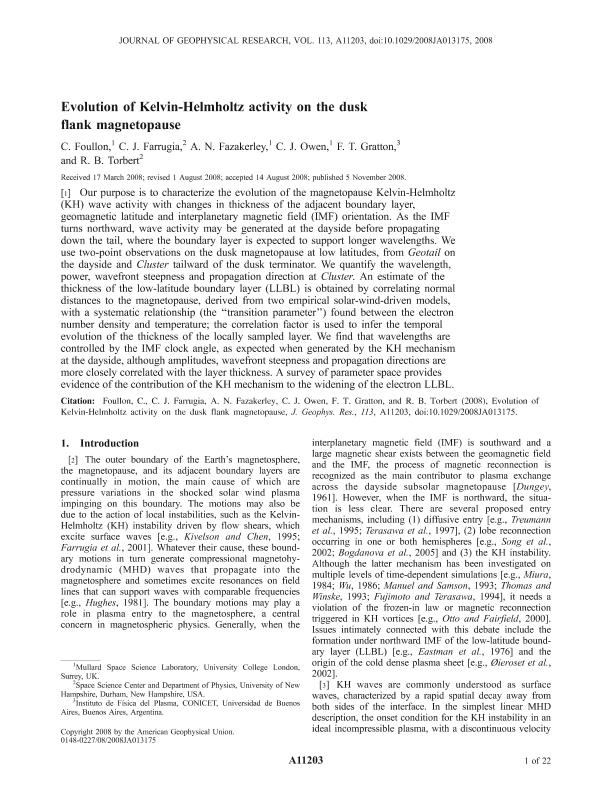Mostrar el registro sencillo del ítem
dc.contributor.author
Foullon, C.
dc.contributor.author
Farrugia, C. J.
dc.contributor.author
Fazakerley, A. N.
dc.contributor.author
Owen, C. J.
dc.contributor.author
Gratton, Fausto Tulio Livio

dc.contributor.author
Torbert, R.
dc.date.available
2020-04-23T14:00:39Z
dc.date.issued
2008-11
dc.identifier.citation
Foullon, C.; Farrugia, C. J.; Fazakerley, A. N.; Owen, C. J.; Gratton, Fausto Tulio Livio; et al.; Evolution of Kelvin-Helmholtz activity on the dusk flank magnetopause; American Geophysical Union; Journal of Geophysical Research; 113; 11; 11-2008; 1-20
dc.identifier.issn
0148-0227
dc.identifier.uri
http://hdl.handle.net/11336/103417
dc.description.abstract
Our purpose is to characterize the evolution of the magnetopause Kelvin-Helmholtz (KH) wave activity with changes in thickness of the adjacent boundary layer, geomagnetic latitude and interplanetary magnetic field (IMF) orientation. As the IMF turns northward, wave activity may be generated at the dayside before propagating down the tail, where the boundary layer is expected to support longer wavelengths. We use two-point observations on the dusk magnetopause at low latitudes, from Geotail on the dayside and Cluster tailward of the dusk terminator. We quantify the wavelength, power, wavefront steepness and propagation direction at Cluster. An estimate of the thickness of the low-latitude boundary layer (LLBL) is obtained by correlating normal distances to the magnetopause, derived from two empirical solar-wind-driven models, with a systematic relationship (the ‘‘transition parameter’’) found between the electron number density and temperature; the correlation factor is used to infer the temporal evolution of the thickness of the locally sampled layer. We find that wavelengths are controlled by the IMF clock angle, as expected when generated by the KH mechanism at the dayside, although amplitudes, wavefront steepness and propagation directions are more closely correlated with the layer thickness. A survey of parameter space provides evidence of the contribution of the KH mechanism to the widening of the electron LLBL.
dc.format
application/pdf
dc.language.iso
eng
dc.publisher
American Geophysical Union

dc.rights
info:eu-repo/semantics/openAccess
dc.rights.uri
https://creativecommons.org/licenses/by-nc-sa/2.5/ar/
dc.subject
KELVIN-HELMHOLTZ
dc.subject
MAGNETOPAUSE
dc.subject
ACTIVITY
dc.subject
FLANK
dc.subject.classification
Física de los Fluidos y Plasma

dc.subject.classification
Ciencias Físicas

dc.subject.classification
CIENCIAS NATURALES Y EXACTAS

dc.title
Evolution of Kelvin-Helmholtz activity on the dusk flank magnetopause
dc.type
info:eu-repo/semantics/article
dc.type
info:ar-repo/semantics/artículo
dc.type
info:eu-repo/semantics/publishedVersion
dc.date.updated
2020-04-21T15:25:35Z
dc.journal.volume
113
dc.journal.number
11
dc.journal.pagination
1-20
dc.journal.pais
Estados Unidos

dc.journal.ciudad
Washington, D. C.
dc.description.fil
Fil: Foullon, C.. University College London; Estados Unidos
dc.description.fil
Fil: Farrugia, C. J.. University of New Hampshire; Estados Unidos
dc.description.fil
Fil: Fazakerley, A. N.. University College London; Estados Unidos
dc.description.fil
Fil: Owen, C. J.. University College London; Estados Unidos
dc.description.fil
Fil: Gratton, Fausto Tulio Livio. Consejo Nacional de Investigaciones Científicas y Técnicas. Oficina de Coordinación Administrativa Ciudad Universitaria. Instituto de Física del Plasma. Universidad de Buenos Aires. Facultad de Ciencias Exactas y Naturales. Instituto de Física del Plasma; Argentina
dc.description.fil
Fil: Torbert, R.. University of New Hampshire; Estados Unidos
dc.journal.title
Journal of Geophysical Research

dc.relation.alternativeid
info:eu-repo/semantics/altIdentifier/doi/https://doi.org/10.1029/2008JA013175
dc.relation.alternativeid
info:eu-repo/semantics/altIdentifier/url/https://agupubs.onlinelibrary.wiley.com/doi/full/10.1029/2008JA013175
Archivos asociados
